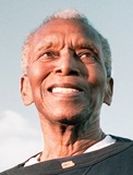 Ted Corbitt ran more miles in training, often up to 200 miles a week, than any runner I ever heard of, yet his fastest time in a marathon was a mediocre 2 hours 26 minutes 44 seconds, almost 24 minutes slower than the present world record for that distance. Top marathon runners today run far fewer miles, usually 100 to 130 miles per week, but they do training runs that are much faster. To compete successfully today, you have to run very fast and the best way to prepare yourself for fast running is to do interval training: repeat very fast runs at shorter distances, at a very fast pace, with slower jogs between each, two or three times a week.
Ted Corbitt ran more miles in training, often up to 200 miles a week, than any runner I ever heard of, yet his fastest time in a marathon was a mediocre 2 hours 26 minutes 44 seconds, almost 24 minutes slower than the present world record for that distance. Top marathon runners today run far fewer miles, usually 100 to 130 miles per week, but they do training runs that are much faster. To compete successfully today, you have to run very fast and the best way to prepare yourself for fast running is to do interval training: repeat very fast runs at shorter distances, at a very fast pace, with slower jogs between each, two or three times a week.Corbitt competed in 199 marathons and ultra-marathons and was good enough to make the 1952 United States Olympic marathon team. He held American records in the marathon, the 100-mile run and the 25-, 40- and 50-kilometer races and continued to be an elite runner into his late fifties. Corbitt ran a few of his marathons with a mediocre marathoner, me (a personal friend), and we were both elected to the Road Runners’ Club of American’s Hall of Fame. At age 81, he walked 240 miles in a six-day race, and at age 82, he improved his distance to 303 miles. He died at age 88 of colon cancer.
A Life in Running
He was the grandson of slaves and started running as a child on his father’s cotton farm in South Carolina and continued to run for all of his 88 years. His family moved to Cincinnati where he ran competitively in high school and at the University of Cincinnati. He was in the army during World War II and then moved to New York, where, in 1950, he earned a master’s degree in physical therapy at New York University. In 1951, he ran his first Boston Marathon. He raced almost every week and ran prodigious amounts of miles each week. In 1957, he helped start the Road Runners Club of America. In 1958, he was a co-founder of the New York Road Runners Club and its first president. He was active in administering long distance running in the Amateur Athletic Union of the United States and helped start masters’ races for men over 40 years of age. He was the prime mover in establishing rules for measuring long distance road race courses.
His Legendary Training Programs
While working as a physical therapist at the International Center for the Disabled on East 24th Street in Manhattan, he ran to work from his home in the Bronx most days, covering from 20 to 30 miles a day. He frequently ran 200 miles a week, and in 1962, he ran 300 miles of training in one week. He once ran the marathon distance every day for a month. In 2003, at age 84, he completed 68 miles in a 24-hour race.
Cause of Death
At age 88, Corbitt died of colon cancer. His lifetime of running prodigious amounts of miles helped to protect him from getting a heart attack, but his running did not protect him from a diet that included a lot of red meat. Red meat and processed meats are strongly associated with increased risk for developing colon cancer. Corbitt was a vegetarian for a few years, but he noticed that he did not stop bleeding when he cut himself. He started eating red meat again and felt that this returned his clotting time to normal.
At the time of his death, Corbitt also had prostate cancer, which is very common in older men who die from other causes. All endurance athletes have to, and should, take large amounts of sugar during races and long runs just to get through their events, but this may have increased his risk for prostate cancer. It is safe to take sugar during intense exercise as contracting muscles draw sugar rapidly from the bloodstream to prevent a high rise in blood sugar. However, many runners get into the habit of taking sugar when they are not running. This can cause high blood sugar levels that are associated with increased risk for cell damage, certain cancers and diabetes.
How Endurance Running Helps to Prevent Heart Attacks.
Heart attacks are extremely rare among marathon runners (Sports Health, 2010 Jul; 2(4): 301–306; Med Sci Sports Exerc, June, 1987;19(3):187-94). Heart attacks are caused by a sudden complete obstruction of the blood flow to a part of the heart muscle. First a part of a plaque breaks off from the rest of the plaque lining an artery leading to the heart. Then the still-attached part of the plaque bleeds and clots and the clot extends to block all blood flow to a part of the heart muscle. Then that part of the heart muscle, lacking oxygen, dies. Running helps to stabilize plaques so they are far less likely to break off to start the process toward suffering a heart attack (Circulation, April 27, 2017;136:138-148 and May 2, 2017;136:126-137). Thus running markedly reduces a person’s chances of developing a heart attack, but does not guarantee complete immunity from suffering a heart attack because exercise does not prevent plaques from forming in arteries.
Notable heart attack deaths among younger marathon runners have included:
• James Fixx, author of The Complete Book of Running, at age 52,
• Brian Maxwell, ranked third fastest marathoner in the world, in 1977 at age 51
• Tom Fleming, winner of multiple marathons who was inducted into the Road Runners Club of America Distance Running Hall of Fame, at age 65
• Micah True, ultramarathoner and subject of the national bestseller Born to Run, at age 58.
Micah True worked to preserve the heritage of the noted tribe of “super-runners” from Mexico, the Tarahumaras, who eat a diet that is 90 percent vegan. However, while they have amazing endurance, the Tarahumaras are not considered to be the best runners because they run too slowly. The fastest endurance runners are the Kenyans, who eat lots of beef and milk. On the other hand, Yannis Kouros, once one of the world greatest road ultra runners, is a vegetarian. Kouros starred in the movie, The Story of the Marathon: A Hero’s Journey, on the history of marathon running. His people, who live on the Greek island of Ikaria, eat fish and locally-grown produce instead of meat and they suffer half the heart attack rate that North Americans have. Substituting plants for animal foods is associated with living a longer life (JAMA Internal Medicine, 2016;176(10):1453-1463).
Lessons from Ted Corbitt’s Life and Death
Running is healthful and can help to prolong your life by helping to prevent obesity, diabetes, heart attacks, strokes, and many different cancers, but no amount of exercise offers complete protection from these diseases. No matter how much you exercise, you still should also follow a healthful diet that includes a variety of vegetables, fruits, nuts, beans, whole grains and other seeds. Sugared drinks and foods can be used for energy during intense exercise, but when you are not exercising they should be limited. I also recommend restricting processed meats, meat from mammals and fried foods. Colon cancer in particular is associated with regular consumption of meat. If you are overweight or diabetic you should restrict all foods made from refined carbohydrates, which includes foods made from ground-up grains (flour) such as bakery products and pasta. Exercising and eating a healthful diet offer you the best protection from a wide variety of diseases and disabling conditions.
January 31, 1919 – December 12, 2007


